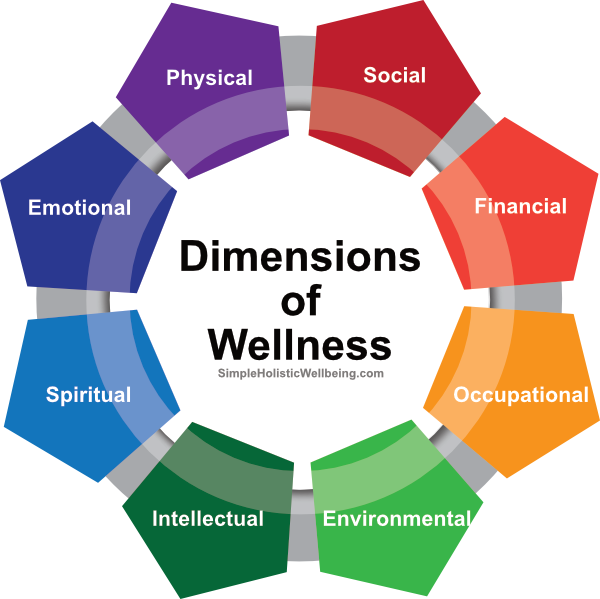Do you know how many dimensions of wellness there are? A holistic approach to life and well being considers all of them to be important. But what are they?
There are different answers depending on who you ask, but we have identified eight: physical, social, financial, occupational, emotional, environmental, spiritual and intellectual.
But achieving true wellness is not as simple as starting a mindfulness routine, exercising or eating well, although it will all help. Many people fail to recognize that there are multiple dimensions of wellness and may focus on some and not others.
If you’re striving to achieve holistic wellness, it’s time to bring awareness to all of them. In this article we are going to look at how many dimensions of wellness there are, and what each can mean for your well being.

What is wellness in terms of well being?
“the active pursuit of activities, choices, and lifestyles that lead to a state of holistic health”
The concept of wellness has been around for centuries with ancient Greece having a theory that can be seen in the modern understanding of holistic health. According to the Greeks, wellness was not just a lack of disease but rather a dynamic balance of multiple dimensions of well being. These dimensions included physical, mental as well as social well being and were considered crucial to one’s overall wellness.
In simple words, wellness is a concept that describes an ideal state of holistic well being. It’s not a singular element, but multiple interconnected dimensions. Once you’re able to positively influence most, if not all, of the wellness dimensions, you’ll be able to experience more holistic well being in your life.
Are health and Wellness the same thing?
Wellness and health are used interchangeably so you might assume they are the same. But there’s a stark difference between health and wellness. According to WHO, health is the state of complete physical, mental, and social well being rather than just a lack of disease.
On the other hand, the National Wellness Institute says that wellness is a process where people make active and aware choices toward a fulfilling and successful life. Given how many dimensions of wellness there are, wellness is focused on positively improving your lifestyle in all aspects.

So how many dimensions of wellness are there?
The answer to this varies as there is a continuum or overlap between the various categories, so we have gone with 8 main dimensions of wellness. Let’s start with the most obvious one…
Physical Wellness
When we think of physical wellness, we think of no chronic illnesses and maybe fit enough exercise now and then. But let me challenge you with what physical wellness means. Physical wellness is not limited to a lack of diseases but rather focuses on the overall health of your physical body.
Physical wellness is dependent on many factors such as physical fitness, nutrition, and the quality of your sleep and exercise. Furthermore, lifestyle habits like smoking and drinking are considered to make you physically unwell!
Social Wellness
Social wellness is a measure of our ability to establish, maintain and foster meaningful and healthy relationships with others. Humans are social beings and interacting with one another directly impacts their health. In fact, it has been proven that social isolation can cause serious health conditions in the long run.
Socially isolated individuals are 50% more likely to have dementia, 29% more likely to develop heart diseases, and 32% more likely to have a stroke. According to a report by NASEM, one-third of adults feel lonely, indicating that they are facing social unwellness.
Financial Wellness
Defined as your financial state, financial wellness takes your financial resources into consideration.
Having a sustainable income for your household size and at least 6 months of income saved as emergency funds are good benchmarks. This means you have an ability to cope with unexpected emergencies.
Budgeting means you will be able to predict your expenditure, know how much money you can comfortably invest in your well being and to achieve long-term goals like college funds and retirement.
Occupational Wellness
Do you ever feel like you’re in a meaningless job that doesn’t spark your passion as it did before? If you said yes, consider focusing on occupational wellness! Occupational wellness is when you feel fulfilled and satisfied with your career. Work doesn’t have to be a source of stress, even if it seems prevalent in today’s work culture.
Instead, work should incite passion as well as motivate you to enjoy what you do and succeed at it! Job satisfaction and a positive work environment are also parts of being occupationally well. In the end, this results in promoting personal growth and helping you feel accomplished.
Emotional Wellness
Emotionally well individuals are better able to maintain and manage their emotions, bouncing back from negative ones and enjoying positive ones when they arise.
Emotional wellness reflects how well you deal with stress and unforeseen circumstances and how you react to situations outside your control. If you’re feeling stressed lately and out of control, practicing emotional wellness can bring you inner peace, empathy, and contentment.
Environmental Wellness
Have you ever wondered why vacations end up helping us feel relaxed and comfortable? That’s because your external environment directly impacts your mental state of well-being! According to Princeton University, environmental wellness refers to your interactions with your surroundings and the livability of your environment.
Having a clean and concise environment with minimal clutter can elevate moods and improve productivity. Surrounding yourself with nature, and natural sunlight along with contributing to the environment by recycling are all important aspects of environmental wellness.
If you’ve thought about why natural locations around the world are tourist hotspots, it’s because the natural element vastly improves your environmental wellness and you get that vacation glow!
Spiritual Wellness
Beliefs are a core of every person, regardless of their religion or upbringing. Using those beliefs to cultivate a sense of purpose, meaning, and interconnectedness can help your mental state in more ways than one. Spiritual wellness is defined as the ability of a person to use their personal beliefs as a way to rationalize what life throws at them.
So it’s essential to have strong and positive beliefs that can uplift you from every hurdle of life. But how do you do that? By praying, practicing personal reflection, and connecting to the universe through the small joys of life!
Intellectual Wellness
Just the way our physical body needs to be stimulated with exercise to stay healthy, our brain does too! Intellectual wellness is of having a curious and active mind that seeks knowledge and mental challenges. This dimension of wellness opens you up to a new world of learning, personal growth, and ideas.
Intellectual wellness can be stimulated in a lot of ways, including reading books and attending workshops to simply picking up a new hobby like chess. Each of these activates your brain to think critically, analyze information and solve problems.
How many dimensions of wellness do you want to improve?
We have gone through the 8 dimensions of wellness above. Now we will discuss some ways on how to improve each of them.
How to improve physical wellness and well being
- Exercising regularly: Move your body actively for at least 30 minutes every day. From walking along your neighborhood, swimming on sunny days, or heading to the gym for a workout, there are many ways to get your body moving!
- Get enough sleep: Quality sleep plays a key role in improving your physical and mental well-being. Aim to get 7-8 hours of uninterrupted sleep every night and don’t forget to enforce a timed routine for sleeping! We also have some tips here on how to sleep better.
- Eat a balanced diet: Having a balanced diet helps your body get healthy fats, carbohydrates, proteins, vitamins, and minerals it needs to fight diseases and grow. You can easily create delicious meals thanks to healthy recipes online.
How to improve social wellness and well being
There are a many ways to strengthen your social wellness and the secret is to find the ones that work for you. Two suggestions are to:
- Share your feelings honestly: Developing open communication skills where you can be honestly expressive of your feelings can deeply help improve your social wellness.
- Build health and meaningful relationships: Surround yourself with good people who offer you valuable advice and unconditional support! Catch up with your friends and family often to maintain these healthy relationships and don’t be afraid to let go of the negative ones in your life.
How to improve financial wellness and well being
- Begin budgeting your expenses: Budgeting can save you more than you could otherwise. It also helps you feel in control of your cash flow so invest some time into budgeting for each month.
- Build savings and pay off debts: Categorize all your debts into either bad debts or good debts. Start by paying off the bad debts as quickly as possible and slowly work your way to building savings and paying off the remaining good debts.
How to improve occupational wellness and well being
Many people suffer from occupational unwellness and subsequently feel the fear of unfulfilled dreams. To get back your passion, practice some of these occupational wellness methods:
- Increase your knowledge and skills: Investing in yourself in terms of knowledge and skill can skyrocket your career as higher-ups notice your diverse importance to their company. Take courses online or pay for training sessions that will help propel your career!
- Work consistently towards your goals: Motivation to enjoy your work and to strive for the ultimate goal can make the biggest difference in your occupational wellness. Whether it’s a promotion or a successful project completion, make sure to hustle for it.
How to improve emotional wellness and well being
The National Institutes of Health have many incredible resources and practices when it comes to improving your emotional wellness and well-being. Here are some ways to improve your emotional wellness:
- Practice mindfulness: Mindfulness helps you become aware of things inside and outside you and can be done by focusing on your breathing and emotions. Simply staying present at the moment also counts as mindfulness.
- Ask for help whenever you need it: If you’re the sole caregiver or are struggling with strong emotions that you can’t easily bounce back, let a professional or a friend help you manage yourself better. There’s no shame in admitting you need a hand here and there!
How to improve environmental wellness and well being
Environmental wellness can be practiced strategically without making you feel limited in your options. Check out how to improve this dimension of wellness:
- Limit your screen time: While we acknowledge how important technology is in your life, limiting screen time can be as freeing as one can imagine. Put away any screen during meal times, family time, and before bed.
- Declutter and use eco-friendly materials: Having a cleaner and more precise room setting can help improve your mood. Declutter any items that aren’t of daily use and replace your household items with eco-friendly materials. It can be as small as using steel straws and paper bags!
How to improve spiritual wellness and well being
Spiritual well-being is just as important as your physical health and has little to do with religious preferences. Here’s how you can improve your spiritual wellness:
- Spend time in nature: Nature is often regarded as the best healer out there, so spend time in a local park. You can set up a picnic for yourself and watch birds or head to the beach for some fun!
- Volunteer to help others: Helping out the less fortunate out there can help you feel positive emotions that improve your spiritual well-being. So don’t shy away from giving away old items to charities, volunteering for community activities, or simply helping out friends and family.
How to improve intellectual wellness and well being
Keeping your mind active is just as important as keeping your body active. Improve your intellectual wellness with these ideas:
- Learn new things: a language, a new topic of interest, a musical instrument, even something to enable to to enhance or change your vocation.
- Play games that stimulate your mind: Crosswords and sudoku are proven to increase intellectual wellness as it engages your brain to work systematically.
- Socialize with new people: Meeting new people can open you up to a universe of diverse ideas, beliefs, and characters that can mentally stimulate you. Join a local club or find new groups online!
Conclusion
Wellness is a multi-faceted concept that has a profound impact on our health and well being. But when it comes down to practicing wellness, there is no “one-size-fits-all” because of how many dimensions of wellness exist. They work together to improve our lives and help us achieve happy and healthy life.
When it comes to focusing on your holistic well being, ask yourself this question: how many dimensions of wellness are you lacking awareness and focus on? Where do you need to prioritize your wellness?
So that is a lot of information about how many dimensions of wellness there are. Please comment below with your thoughts about the topics mentioned in this article below.





